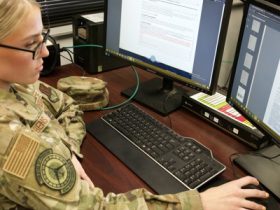WIESBADEN, Germany − The U.S. Army is prioritizing a common launcher that could be used across the European alliance from which a wide variety of weapons could be fired, the service’s chief in charge of the European and African theaters, said last week.
As part of a newly announced Eastern Flank Deterrence Line, a regional plan focused on the Baltic states, the U.S. Army and its allies and partners plan to pursue key ground-based capabilities.
“Everyone loves to talk about long-range fires and air defense,” Gen. Christopher Donahue, U.S. Army Europe and Africa’s commander, said at the Association of the U.S. Army’s inaugural LandEuro conference in Wiesbaden, Germany.
“So specifically, what we want to develop is a common launcher … that is both offensive and defensive capable. We want a common fire control system so that any nation can use that fire control system,” he said. “Then obviously, we want everything to be optionally manned. If we look out for an air defense system or a long-range fire system, we want it to be one system, optionally manned, where we’ll be able to take munitions from any country and shoot through them.”
Donahue acknowledged the existence of the bureaucracy that has bogged down previous weapons development and the foreign military sales process.
Even so, he said, “The United States has taken on reform of foreign military sales, and you’re already seeing the changes that are coming. We already know that we’re now having actual things that will be allowed to move at a higher rate of speed and getting them to move faster.”
In the past, the Army has struggled to develop a multi-mission launcher that can take on a wide variety of missiles; particularly ones that focused on something that could fire interceptors that can defeat anything from drones, cruise missiles and rockets, artillery and mortars.
The service canceled a MML program in 2019 and has yet to select and qualify a second interceptor for its Indirect Fires Protection Capability system designed to provide fixed or semi-fixed site protection against RAM, drone and cruise missile threats. The first IFPC prototypes are headed to South Korea this summer.
Donahue said the operational environment in Ukraine and the Middle East has accelerated the development of capabilities that can rapidly configure systems to fire different munitions.
“You look at where technology is, we are at the point where we can actually do it now in all of these conflicts,” Donahue stated. “We look at what’s at play out there and what we’re learning from it and then, because we are watching in Ukraine, you know, with the Middle East, this is forcing technology to mature to the point where we can do that.”
Donahue described the common launcher as something like a High Mobility Artillery Rocket System, or HIMARS — that is used in Ukraine and either owned or on tap to be purchased by nearly 20 countries worldwide — but could be adapted by countries to suit their own industrial investment and operational needs.
“HIMARS is a great long-range system,” Donahue said, “so I’m confident most nations would want that, but they may want to put it on something common with their military.
“You would be able to take that common launcher and if Norway wants to put it onto a wheeled vehicle, they can put that common launcher on the wheeled vehicle,” he continued. We want to make sure that no matter who buys what type of variant of HIMARS rockets or missiles, just using that example, it can be fired through any fire system. Right now, there is not that interoperability so we have to make sure that happens.”
To address the dire need to deepen the magazine depth for global deterrence, Donahue added, “we want to get to the point where you can fire other people’s rockets through these common platforms.”
Here comes CAML
The Army released a “request for solutions” to industry late last month through its Rapid Capabilities and Critical Technologies Office, or RCCTO, for a Common Autonomous Multi-Domain Launcher (CAML).
“CAML is an autonomous/optionally crewed, highly mobile, air transportable, cross-domain fires launcher with the potential to augment or replace existing Army launchers. CAML will be capable of worldwide deployment and operations,” Sam.gov states.
The solicitation, which limits responses to U.S. companies capable of processing and storing secret information and hardware, asks for two separate solutions: A CAML Heavy on an M1075 Palletized Loading System tactical vehicle or similar 15-ton chassis tactical vehicle and a CAML Medium that could fit on Family of Medium Tactical Vehicles.
For CAML-H, the Army is looking for something that could integrate a Tomahawk Land Attack Missile (TLAM) used in the recently fielded ground-launched Typhon Mid-Range capability missile system or the Patriot Advanced Capability-3 Missile Segment Enhancement interceptors used in Patriot air and missile defense systems.
The CAML-M would be able to fire Multiple Launch Rocket Systems (MRLS) family of munitions used in HIMARS or AIM-9X interceptors used in the IFPC system.
Both systems would be supported by an Autonomous Resupply Vehicle “capable of autonomously reloading pods/canisters of missiles,” the request states, “with minimal to no human intervention.”
RCCTO plans to rapidly prototype 1 CAML-M with MLRS family of munitions within 18 months and another with IFPC-capable missiles within 24 months and an ARV within 36 months from date of the contract award, the solicitation lays out.
Within 24 months, the Army will produce four TLAM-capable CAML-H prototypes within 18 months and one MSE-capable prototype within 24 months.
The tech is there
Lockheed has ownership over a variety of systems that could be involved in the CAML effort — from MLRS to Typhon to PAC-3 MSE.
HIMARS would be tuned to fire not just offensive weapons but defensive ones as well, Jason Reynolds, Lockheed Martin’s vice president for integrated air and missile defense in its missiles and fire control sector, told Defense News in an interview at LandEuro. The systems would also all be mobile as opposed to the current configuration of defensive systems, which are typically trailer-based like Patriots are today.
“What we’re learning in the real world is, if you’re mobile, you’re more survivable,” Reynolds stated.
Technologically, the prototypes could be done relatively quickly if investment from the government puts the program in the HOV lane, he noted.
“I don’t think there’s anything technically that would prohibit that because these are existing systems today,” Reynolds said. “You might have to combine some of the electronics, you might have to redesign some of the circuit cards, you might have to repackage some of these items to put it onto that vehicle, whatever the new vehicle is, but it’s not like you’re inventing something, you’re just repackaging.”
For Lockheed, its ship-based Mark 41 launcher, which was adapted for the ground-launched Typhon system for the U.S. Army, already has missile load-out flexibility.
“It really provides the ability to bring and load out any mix of defensive- and strike-based capability missiles that anybody that’s a Mark 41 user wants to employ,” Edward Dobeck, company program director for launching systems within its rotary and mission systems division, told Defense News in an interview this week.
Typhon successfully sank a ship off the coast of Australia last week during U.S.-Australia-led exercise Talisman Sabre.
HIMARS have also demonstrated autonomous capability during the most recent capstone event as part of the Army’s experimentation campaign known as Project Convergence.
“Those are some of the technologies we’ve demonstrated that we think are the sorts of things that could be leveraged on CAML,” Paula Hartley, Lockheed’s vice president of tactical missile within the MFC business, told Defense News in the same interview.
“It’s not a new missile system or munitions, it’s just putting it all together and the government moved pretty briskly in this and I think that we have responded extremely well in helping them do that,” she said.
Jen Judson is an award-winning journalist covering land warfare for Defense News. She has also worked for Politico and Inside Defense. She holds a Master of Science degree in journalism from Boston University and a Bachelor of Arts degree from Kenyon College.
Read the full article here








Leave a Reply